Parrot gray: description of species, features of content, selection rules
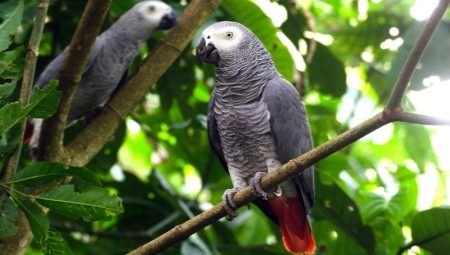
Today, families without pets are not often found. In addition to the most popular dogs and cats, it is worth highlighting the parrots. The gray parrot is an intelligent bird, thanks to which it gets along well with people indoors, and since birds are long-livers, such a pet can live side by side with a person throughout his life.
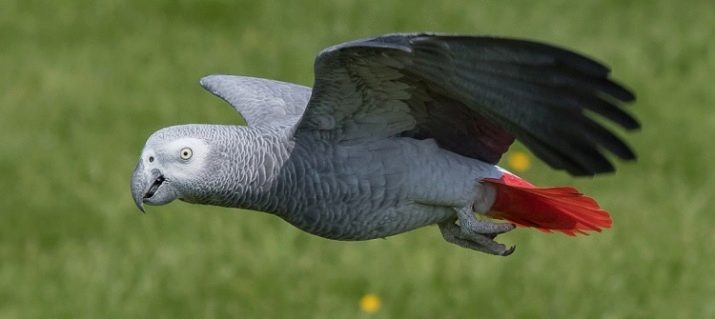
Description
The Jaco is a fairly popular bird that is scientifically referred to as the African Gray Parrot Psittacus, which means “African gray parrot”. Thanks to the unique character of this feathered one, a peculiar cheerful and enchanting atmosphere will reign in the dwellings where the gray has settled. The bird comes from the parrot family and is the only member of the stupid genus. Since the gray is still an exotic bird, before purchasing, it is recommended to study in detail its nature and features of the content.
The dimensions of an adult are about 30-35 centimeters, while the average wingspan can exceed 60 centimeters. The wing itself has a length of about 20-25 centimeters, the end of the wing is strongly developed. The tail of a gray parrot is small, its length will not be more than 8-9 centimeters.
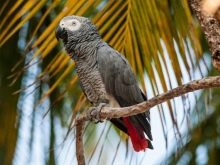
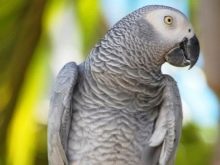
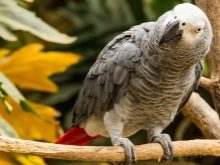
Adult birds are distinguished by their down-curved black beaks, gray limbs and bright yellow irises.
The breed is distinguished by leathery nostrils and a bridle located in the region of the bird's eyes.Birds can have several color options for their plumage: today you can find parrots with color in the color palette of mouse shades, as well as bright purple-red grays. As a rule, external features relate to gender. - Males have a more powerful beak and thickened skull, while the head of a female individual repeats the domed shape. However, after the bird grows up, external differences will no longer be pronounced.


Jaco - NSit is a talking parrot that can be kept at home. The bird has the ability to imitate a human voice, in addition, Grays are long-livers who can live in a family for at least seven decades. Among the birds of this breed, there were also individuals that lived up to 90 years.
As for the natural environment where the gray parrot lives, there the birds sometimes emit a rather shrill cry and even whistle, while clicking their beak quite loudly. At home, the bird can also behave extremely emotionally, but these character traits can be smoothed out if you give the pet proper attention, engage in its development, and take proper care of it. It is noted that the gray throughout life stands out for its extremely high memorability and observation.
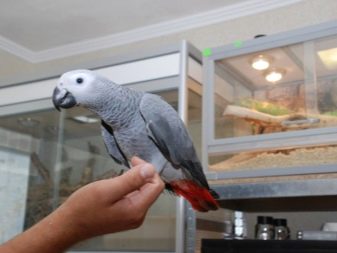
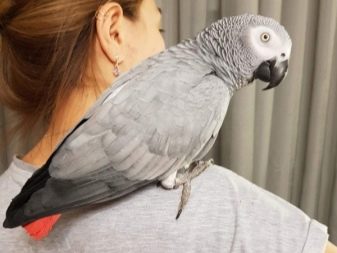
Where does it live?
The name of the bird was not accidental, because Africa is considered to be its homeland. Depending on the breed of bird, the areas of dispersal of individuals across the continent slightly differ. So, the red-tailed bird inhabits the Congo and Tanzania, and the brown-tailed species prefers the areas of Liberia, Guinea and Sierra Leone. However, today a similar bird can be found all over the world. Jaco fly a little hard, in the wild they can make long flights with the aim of attacking farmland.
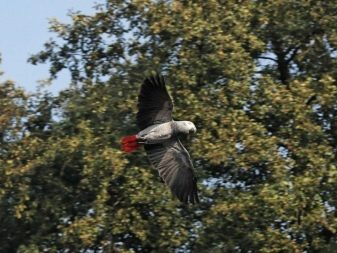
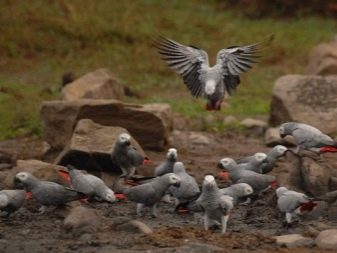
Birds spend the night on the tops of green trees, settling there closer to sunset. Due to their tenacious, clawed limbs and beak, they climb well along the trunks of fruit crops in search of delicacies, and Grays descend to the ground for water, usually in the first half of the day.
Local people hunt large birds for meat and to sell chicks.
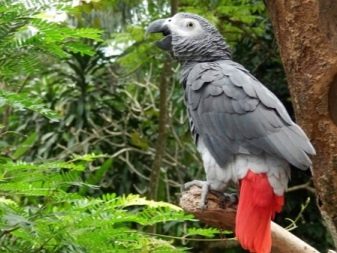

Views
The division of the breed into species is carried out according to external signs concerning the color of the tail. Today, in the natural environment and in dwellings, there are two main species and a subspecies of exotic birds.
Red-tailed parrot
Such a bird grows in length up to 37 centimeters, the predominant color of the plumage is light gray. In this case, the color of the feathers on the tail will strongly contrast with the body, since it highlighted by a bright red feather tint.
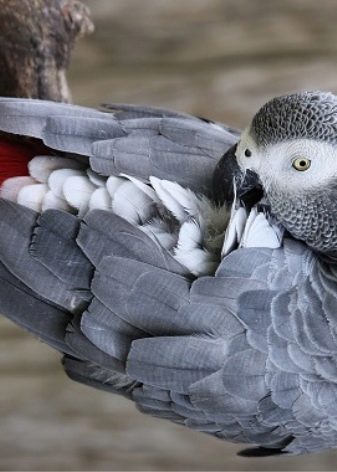
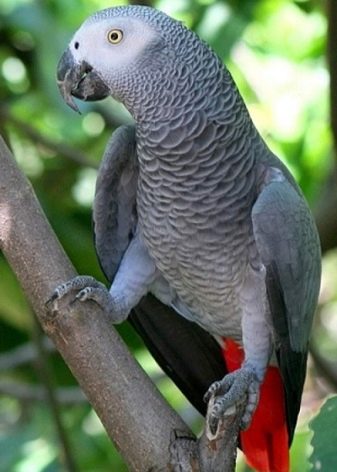
Brown-tailed gray
The bird will be slightly smaller in size than the previous species - the average parameters of an adult parrot will not exceed 30 centimeters. In this case, the gray plumage is somewhat darker than that of the red-tailed relative. The feather on the tail is painted in a brownish-red tone, the beak has a shade of ivory.

Royal subspecies
The bird looks almost like a brown-tailed parrot, the similarity is observed in the color of the plumage. However, due to artificial mutation, today you can find birds with an absolutely white color, as well as gray-pink parrots.
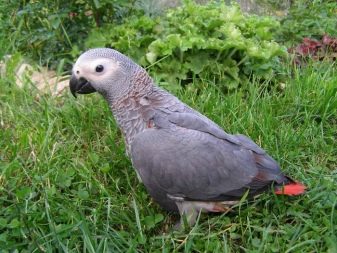

How to choose?
If you plan to keep only one bird of this breed in the house, then experts recommend purchasing a male at a young age. Since it is the male that will get used to the new place much faster.
There are several guidelines for choosing an exotic bird.
- First of all offers to sell Grays from specialized and certified nurseries should be considered. All parrots presented must be ringed. The fixed ring should contain basic information about the pet.
- Fosterling chick will be completely tame, it will have smooth scales on its legs, and its beak will also be smooth.You can distinguish young animals by black eyes, which only turn yellow by one and a half to two years. The optimal age for a chick to purchase is 3-4 months.
- When buying an adult parrot it is necessary to pay attention to his behavior in contact with humans, since some unscrupulous sellers sell wild birds under the guise of tame birds. If a parrot screams loudly at the sight of a person, then such an individual most likely has not been trained, so serious problems can arise with it at home.
- The ability to speak the sex of the parrot has no effect, therefore, both the female and the male can be taught to imitate human speech at home.

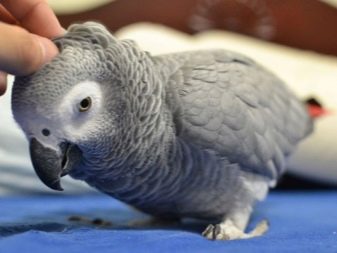
It should be remembered that parrots are social birds, therefore, it is important for them to interact with all family members. If over time its composition increases or there is another pet in the dwelling, it is important to correctly distribute attention to everyone.
As a rule, Grays can get along well in the same area with dogs, and even cats, however, strict control of the owners in this case will be mandatory.
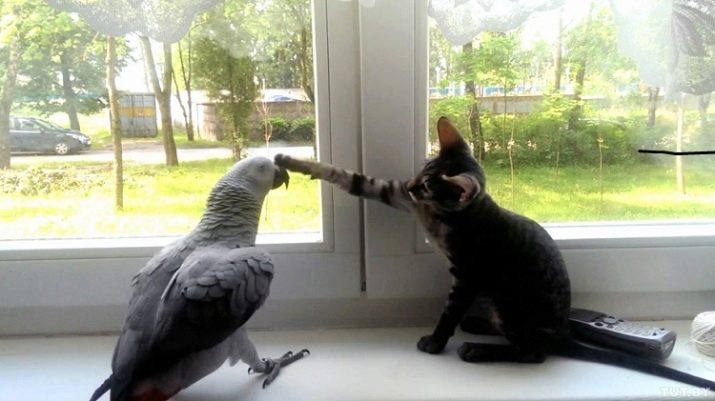
Content rules
It is worth highlighting the main features that relate to the maintenance of an exotic talking bird in a living room.
Cell selection
A house for a parrot is selected taking into account its type and size, as well as the number of birds that are planned to be kept in one cage. So, optimal dimensions for a bird house the dimensions will be 65x45x80 centimeters, this applies to housing for one bird.
Since the Grays have a rather powerful beak, the rods at the cage should have a diameter of at least 3 millimeters. Reliable fasteners will also be required for feeders and sippy cups placed inside. For a parrot, it is worth choosing cells containing an insert of plexiglass, in the lower part there should be protective grill.
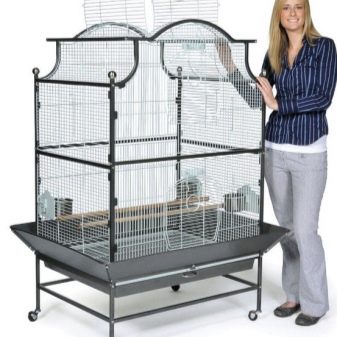
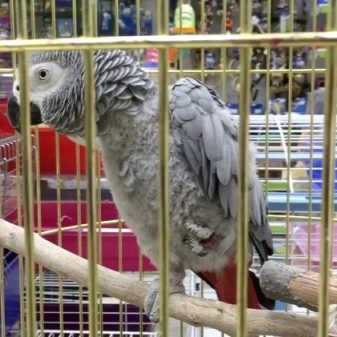
Since the exotic bird stands out for its intelligence and good memory, it is worth considering options for a dwelling with a type of castle that a gray cannot open on his own. For additional comfort, parrot owners are offered mobile cages that have wheels at the bottom.
The inner filling of the cage is also important: in addition to the insert for the care of the beak, the bird will need a variety of twigs, sticks and twigs, it is preferable to use parts of fruit trees. There should be a lot of toys in the cage, Accessories for playing with a treat placed inside are very popular.
The cage should contain disinfected coarse sand. It is recommended to clean the cage without using household chemicals at least once a week or as it gets dirty.
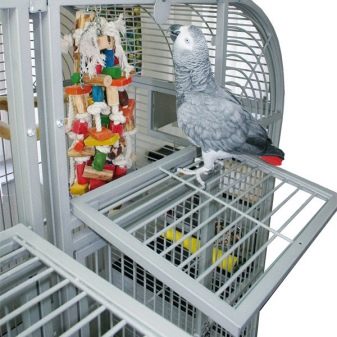
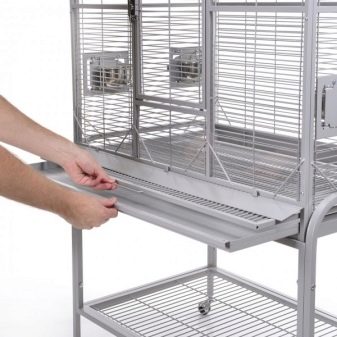
Nutrition
Parrot food is placed in feeders fixed in the cage; they must be made of impact-resistant polymer, ceramics or stainless steel. Birds eat different food, respectively, there should be three or four feeders in the cage. In addition, care should be taken to have a drinker in the cage. However, a balanced feeding of various fruits and vegetables to Grays will enable the bird to replenish its water balance, so it can rarely go to water.
It is required to feed the parrot at home in such a way that so that the vitamin and mineral composition of food is as close as possible to natural conditions. Ptah should be introduced to new feeds gradually and with extreme caution. All types of fruits and vegetables used should be fresh, and the diet should be varied. The presence of cereals, nuts, and also herbaceous plants recommended for parrots in the feeder has a positive effect on the health of the bird.
As for corn and wheat, such cereals are best offered to your pet in a germinated form.
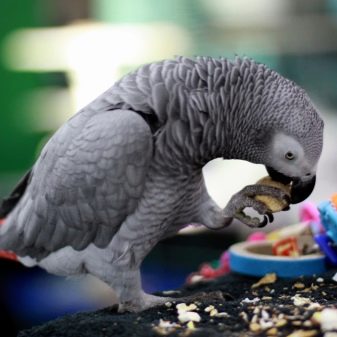
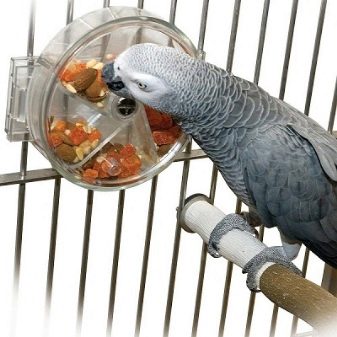
An alternative to the above foods are dry options, but in this case, water must be present in the cage without fail. It is more correct to use filtered liquid, if this is not possible, then tap water should be allowed to stand for at least a day. From time to time, you can purchase non-carbonated mineral water for the gray, which will have a positive effect on the digestion and immunity of the bird.
In the wild, a parrot's diet will vary with the season, so some changes in the fruits and vegetables used may be at home. It is prohibited to feed the parrot from the common family table, despite the fact that the bird will show a genuine interest in the food of the household. This is due to the potential danger of most dishes for parrots, as an exception, fruits and vegetables can be.
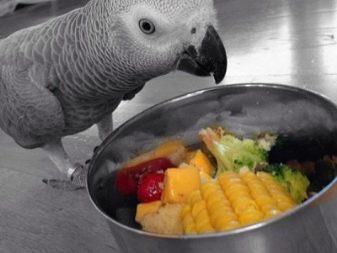

Hygiene
The most important care nuance is bathing the parrot. These birds love aquatic treatments because bathing allows them to keep their plumage, skin, beak and limbs clean. It is recommended to carry out water procedures regularly, but without fail avoiding drafts and lowering the air temperature in the room after the hygienic measures of the bird.
A white powdery coating may appear on the feathers of a Grays. This is a physiological norm that allows the pet to maintain its plumage in a normal state. To bathe and control the amount of powder on the wings, the owner can spray the bird with warm water from a spray bottle. Also, the bird is able to swim on its own, for this it will need a container of water.
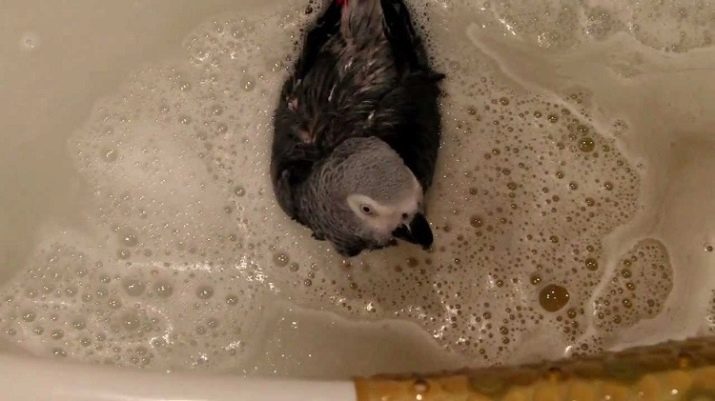
As for breeding and pairing, then exotic birds are quite selective in their choice of mate, especially in captivity. Some individuals spend their entire lives alone. And even the cohabitation of two opposite-sex parrots does not at all guarantee that they will create a pair.
But if this still happened, then for the "lovers" it is necessary to select a nesting site in which the female, some time after mating, will lay several eggs. Incubation lasts about 30 days, the female is engaged in this, and the male provides food. Juveniles will fully fledge closer to three months, until that time the parents will take care and feed the chicks.
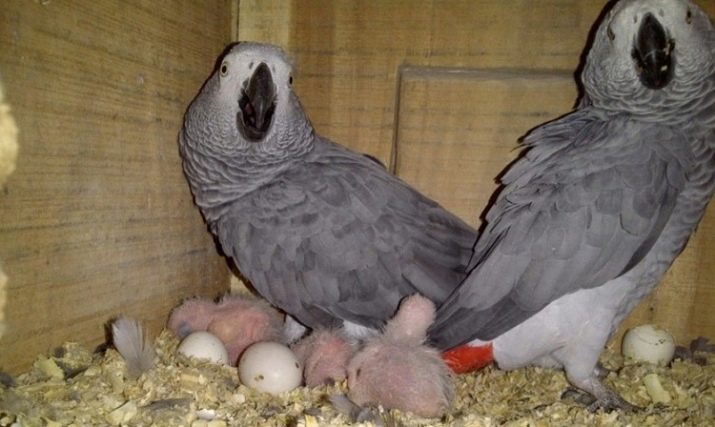
It is forbidden to clip the wings of a gray living at home, since they give the bird a certain amount of physical activity. The bird simply cannot get it in any other way, which will have an extremely negative effect on its health.
The bird can die due to contact with electrical household devices, glass, therefore, the apartment is an unsafe place for the gray, in which the parrot outside the cage must be closely watched. Particular attention should be paid to windows that must be closed. If the bird is left alone in the room, then the gray must be placed in the cage.
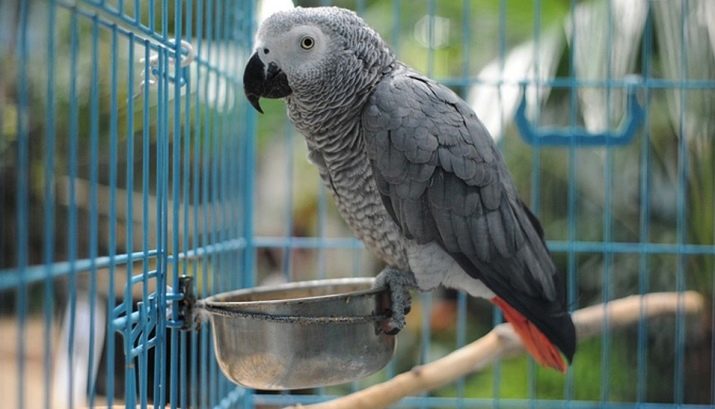
Intelligence
This breed can be safely attributed to the category of the smartest, therefore experts refer the level of intelligence development of a gray exotic guest to a 3-4 year old child. The bird speaks, repeating not only the sounds heard, but also clearly conveying the intonation with which a person pronounces phrases or words. Scientists agree that birds are quite sensitive to the situation, so they can reproduce sounds with a semantic load.
As a rule, games and activities with the bird begin quite early, most of the birds will be ready for this from about 2-3 months. The bird is able to memorize about a hundred words.

Diseases and their treatment
In captivity, this breed suffers from self-plucking. Such an ailment can be provoked by the following points:
- errors related to care, in light of which the birds have appeared parasites;
- psychological trauma;
- inaccuracies regarding nutrition.
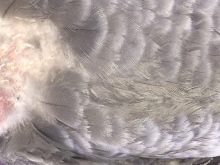
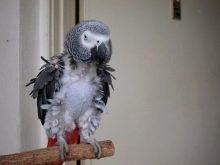
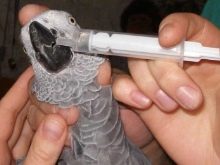
To help the bird get out of this state, the conditions of detention should be established and revised, the parrot should be taken to an appointment with a specialist. Diseases of a parasitic nature, from which a pet can suffer, include helminthiasis. For treatment, you will need to use specialized medications, as well as disinfect the cell. Non-infectious diseases of parrots concern obesity; in order to combat it, it is necessary to reconsider the moments of keeping and feeding Grays. In rare cases, the bird can develop tuberculosis, which cannot be treated.
As a rule, it is possible to determine that a gray parrot suffers from some kind of ailment by its restless behavior. Frequent mood swings, refusal to eat, apathy or irritation will be the first warning signs, indicating that the bird has some kind of health problem.
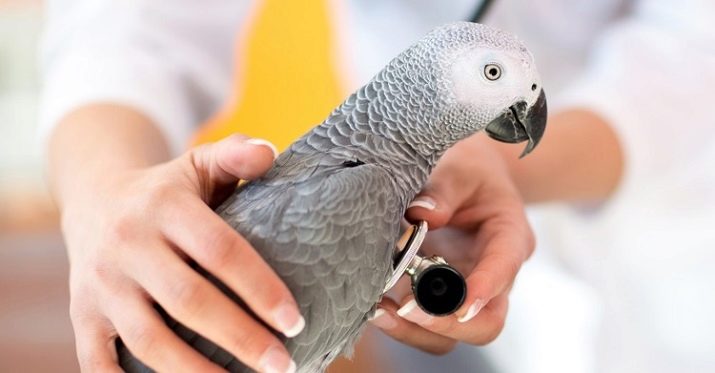
Owner reviews
Most breeders of this breed of parrots characterize it as inquisitive and socially active. However, in order to have a smart and healthy gray in the house, the owner will need to pay maximum attention to the bird. Regular exercises, a balanced diet and competent care will allow you to grow a smart and beautiful individual at home, capable of bringing a lot of positive emotions to both the adult and the younger generation of the family.
In the next video, you will find the peculiarities of keeping, feeding and caring for the gray parrot.








